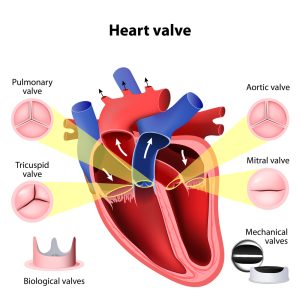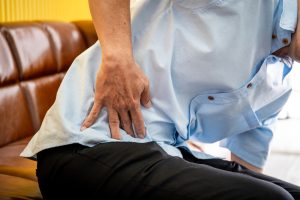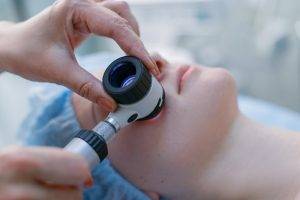The primary function of the heart is to pump blood containing oxygen and nutrients to all parts of the body. The heart consists of four valves that control the flow of blood in the correct direction. They open and close at the right time to prevent the blood from flowing backwards. If you have a heart valve disorder, the valves cannot perform this function properly, disrupting blood flow to the rest of the body, also predisposing to formation of blood clots, strokes, and heart attacks. Most valve problems are first identified as a murmur when listening to the heartbeat.
World Heart Day falls on 29 September this year. Apart from coronary artery disease and heart failure, let’s dive deeper into a lesser known heart disease surrounding the heart valves!
What are the different types of heart valve problems?
There are 4 different heart valves (refer to Diagram 1).
- The tricuspid valve that lies between the right atrium and right ventricle.
- The pulmonary valve that lies between the right ventricle and pulmonary artery.
- The mitral valve that lies between the left atrium and left ventricle.
- The aortic valve that lies between the left ventricle and aorta.

Diagram 1: types of heart valves
If any of the above valves cannot perform their normal function, it results in a heart valve problem. Valve problems fall into 2 main categories:
Valvular Stenosis
Valvular stenosis is the narrowing or stiffening of the heart valve. In this condition, the valve does not open fully, which limits forward flow of blood through it.
Valvular Regurgitation
Regurgitation is a condition in which the valve does not close properly; allowing blood to leak backwards
Sometimes the 2 flaps of the valve do not close smoothly and collapse backwards to form a bulge, resulting in valvular prolapse. This also causes blood to leak backwards i.e. regurgitation.
Valvular problems affect the heart’s pumping efficiency; thus, it cannot supply oxygenated blood to all parts of the body adequately.
What are the causes of valve disorder?
Valve disorder can develop at the time of birth, or it can be acquired.
Congenital causes
The valve disorder happens at the time of birth. Some congenital disorders include:
- Bicuspid aortic valve disease, where the aortic valve has only two leaflets instead of three.
- Ebstein’s anomaly, where there is malformation of tricuspid valve, causing leakage of blood from right ventricle backwards into right atrium, instead of forwards into lungs
Acquired causes
In this case, the valve disorder is acquired due to e.g.:
- Other illnesses e.g. rheumatic fever, lupus, and certain infections.
- Age-related changes e.g. accumulation of calcium on valves with age, leading to stenosis.
- Radiation therapy for cancer
- Heart attack, Coronary heart disease and related risk factors e.g. high blood pressure, diabetes, high cholesterol
What are the symptoms of valve disorder?
Those suffering from valve disorder may experience the following symptoms:
- Discomfort or tightness on the chest between the neck and the upper abdomen.
- Irregular or rapid heartbeat.
- Shortness of breath when you are physically active
- Shortness of breath when lying down, due to pressure and fluid buildup in lungs from heart failure
- A feeling of tiredness while doing routine activities.
- Dizziness or fainting.
- Swelling in feet and ankles caused by fluid buildup due to increased water retention by kidneys in response to heart failure.
How is valve disorder diagnosed?
Once you approach a doctor with any of the above complaints, the doctor will do a physical examination. This includes examining the heart with a stethoscope. If there is a murmur of the heart, it is an indication of valve disorder.
The doctor may also order the tests below to aid in diagnosis of the condition.
- Chest x-ray, to see if the heart is enlarged (from being chronically overworked due to leaky valves and back flow of blood)
- Echocardiogram, which uses sound waves to enable visualisation of the valves and chambers
- Electrocardiogram, to show the electrical activity of the heart/heart rhythm
- Angiogram, where a doctor threads a thin tube (catheter) through a blood vessel in your arm or groin and guides it to an artery in your heart and injects dye through the catheter to make the artery visible on an X-ray; helps evaluate heart muscle function based on blood flow through the arteries and chambers, and also measures blood pressure within the chambers
- Stress/exercise test, to measure your heart’s response to physical exertion
What are the treatments available for valve disorder?
The treatment for valve disorder depends on the severity of the condition.
Medications
Some medications that are commonly prescribed include:
- Diuretics to prevent fluid buildup in the body.
- Blood thinners to reduce other cardiac complications e.g. formation of blood clots and heart attack.
- Anti-arrhythmics to regulate heart rhythm
- Beta-blockers which help control heart rate
- Vasodilators which open up blood vessels
Surgery
When symptoms increase in severity, surgery may be necessary.
- Valve repair:
- It is best to repair a valve and preserve a person’s own heart tissue when possible.
- Balloon valvuloplasty is a repair procedure that can relieve valve tightness. In this minimally invasive procedure, a small catheter holding an expandable balloon is threaded into the heart and placed into the tightened valve. The balloon is then expanded to stretch open the valve and separate the leaflets.
- Valve replacement
- When valve tissue is too damaged, a replacement valve may be used from another human heart, an animal or a manufactured mechanical valve.
Lifestyle changes
Lifestyle changes can help to preserve heart function or minimise symptoms, e.g.:
- Achieving good control of heart disease risk factors like blood pressure, blood sugar and cholesterol
- Eating a heart-healthy diet low in trans fats, saturated fat, salt, and sugar; eating more whole grains, lean poultry, and fish.
- Engage in 30 minutes of physical activity daily, such as brisk walks, to achieve/maintain a healthy body weight.
- Abstain from smoking and alcohol.
- Learn to manage stress such as through relaxation activities, meditation, physical activity, and spending time with family and friends.
Conclusion
If you experience a heart murmur or any of the symptoms mentioned above, it is best to see a doctor without delay. People with valve disorders can still lead healthy, full lives with lifestyle changes, as well as a proper care plan including regular monitoring, and medical or surgical intervention where necessary.












